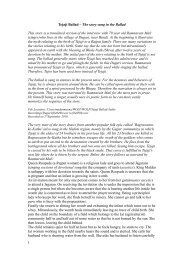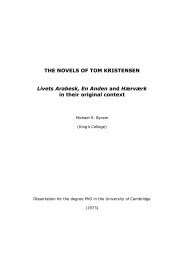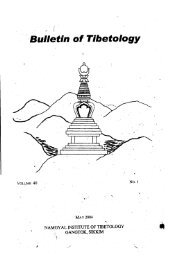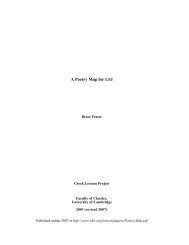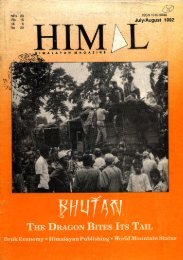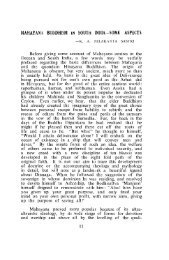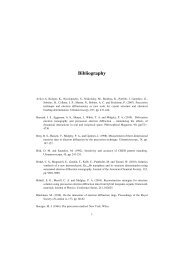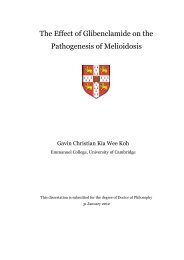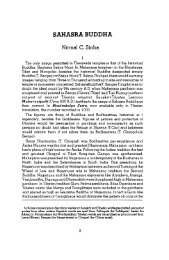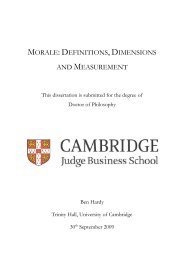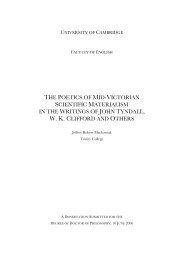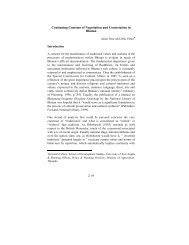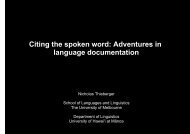The Crusades, the Genoese and the Latin East - DSpace at ...
The Crusades, the Genoese and the Latin East - DSpace at ...
The Crusades, the Genoese and the Latin East - DSpace at ...
Create successful ePaper yourself
Turn your PDF publications into a flip-book with our unique Google optimized e-Paper software.
<strong>The</strong> <strong>Genoese</strong> inhabitants of <strong>the</strong> kingdom of Jerusalem after 1187<br />
<strong>The</strong> <strong>Genoese</strong> community in <strong>the</strong> <strong>L<strong>at</strong>in</strong> <strong>East</strong> after 1187 had been through long trail of hardship until<br />
it established itself as a functioning body with basic facilities th<strong>at</strong> could support <strong>the</strong> community.<br />
Despite <strong>the</strong> fact th<strong>at</strong>, as was already demonstr<strong>at</strong>ed, concessions were generously bestowed on <strong>the</strong><br />
<strong>Genoese</strong> between 1187 <strong>and</strong> 1195, <strong>the</strong> community had many basic needs, from housing <strong>and</strong><br />
commercial facilities to spiritual rights. <strong>The</strong> move to Tyre also meant reloc<strong>at</strong>ion of <strong>the</strong> <strong>Genoese</strong><br />
who already lived in <strong>the</strong> kingdom of Jerusalem. One of <strong>the</strong> questions is who were <strong>the</strong> <strong>Genoese</strong><br />
who settled in Tyre? Were <strong>the</strong>y refugees from <strong>the</strong> rest of <strong>the</strong> kingdom or predominantly new<br />
immigrants, crusaders <strong>and</strong> merchants from Genoa? <strong>The</strong> issue of <strong>the</strong> 1187 refugees <strong>and</strong> <strong>the</strong>ir place<br />
of refuge are interesting. <strong>The</strong> notarial records from 1190 to 1192 do not provide much evidence<br />
about refugees from <strong>the</strong> crusader st<strong>at</strong>es in Genoa itself. Perhaps it should not be surprising<br />
considering th<strong>at</strong> if people escaped as refugees <strong>the</strong>y probably had no capital to invest in <strong>Genoese</strong><br />
trade. Perhaps <strong>the</strong>y could not afford to pay <strong>the</strong> notaries. It should be also made clear th<strong>at</strong> <strong>the</strong>re is<br />
not much evidence in <strong>the</strong> cartularies of traffic coming from <strong>the</strong> <strong>L<strong>at</strong>in</strong> <strong>East</strong> to Genoa even in<br />
peaceful times. Merchants who travelled in th<strong>at</strong> direction carried out <strong>the</strong>ir legal arrangements in<br />
front of notaries in Acre or in Tyre. Shelomo Gotein found evidence of a similar process in <strong>the</strong><br />
case of merchants who travelled to Genoa from Old Cairo 553 With this in mind, it is interesting to<br />
find several cases th<strong>at</strong> seem to be rel<strong>at</strong>ed to <strong>the</strong> fall of <strong>the</strong> first kingdom of Jerusalem. One such<br />
case is of Magalda, wife of lohannes from Jerusalem who was in Genoa on 08 April 1190. She<br />
went to see <strong>the</strong> notary Oberto Scriba with her sons Wuilielmus <strong>and</strong> Martinus. Magalda <strong>and</strong><br />
Wuilielmus made a contract with Martinus <strong>and</strong> h<strong>and</strong>ed over to him a large sum of £370 th<strong>at</strong> he<br />
was to take to his siblings, Iohannes, Symon, <strong>and</strong> Adalaxia:<br />
Confesi fuerunt... Magalda de Jerusalem et Wuilielmus eius filius quod per Martinum<br />
filium predicte Magalde mitebant Ultramare Johanni et Symoni et Adalaxie filiis predicte<br />
Magalde et fr<strong>at</strong>ribus pref<strong>at</strong>i Wuilielmi L370... Et beize fuit cunfesus Martinus quod<br />
predictas res portal... 554<br />
Although <strong>the</strong> document does not specify so, <strong>the</strong> o<strong>the</strong>r children <strong>and</strong> siblings must have<br />
been in Tyre <strong>at</strong> <strong>the</strong> time. This is unfortun<strong>at</strong>ely all <strong>the</strong> inform<strong>at</strong>ion provided in <strong>the</strong> record.<br />
Fur<strong>the</strong>rmore, in <strong>the</strong> cartulary of Oberto Scriba it is <strong>the</strong> only example th<strong>at</strong> seems to be linked to <strong>the</strong><br />
f<strong>at</strong>e of <strong>the</strong> refugees in 1187. <strong>The</strong> contract fails, however, to tell <strong>the</strong> complete story. Magalda <strong>and</strong><br />
553 Oberto de Bramante is one such notary who is known to have worked in Acre in 1218 <strong>and</strong> 1222. See <strong>the</strong><br />
summary of <strong>the</strong> proceedings of a court case from 1224, which mentions <strong>the</strong> role of Oberto as notary in<br />
Acre in 1218: Mag. Sal., nos. 736-739, pp. 308-316; Oberto is also mentioned as <strong>the</strong> notary of Acre in<br />
documents from 1222 which were published as an appendix to Favreau-Lilie's article, 'Friedenssicherung<br />
<strong>and</strong> Kofliktbegrenzung', pp. 444-447. Shelomo D. Goitein, A Mediterranean Society: An Abridgment in<br />
One Volume, ed. Jacob Lassner, (Berkeley, 1999), pp. 36-38,312-3.<br />
5340S9 1190, no. 356. <strong>The</strong> <strong>L<strong>at</strong>in</strong> names of <strong>the</strong>se individuals was used here because<br />
<strong>the</strong>ir identity <strong>and</strong><br />
language are not known.<br />
159



